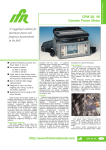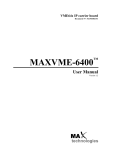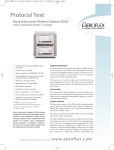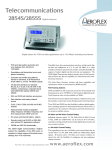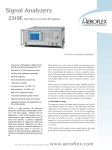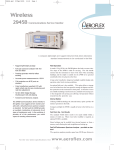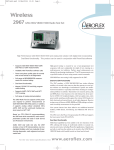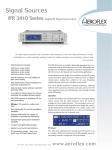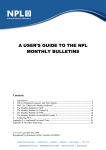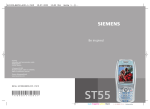Download 6960B RF Power Meter
Transcript
46891067.qxd 03/12/04 11:18 Page 1 Counters & Power Meters 6960B RF Power Meter A precision Power Meter with comprehensive GPIB facilities for ATE requirements and standard bench applications • Extensive frequency coverage: 30 kHz to 46 GHz • Wide dynamic range: -70 dBm (100 pW) to +44 dBm (25 W) • Fast response on GPIB of 25 ms • Auto averaging with manual override • Both 50 Ω and 75 Ω sensors • Low sensor VSWR reduces measurement uncertainty • Sensor linearity correction for improved accuracy • Maximum hold facility • Optional DC operation • Non-volatile memory The 6960B RF Power Meter is a high accuracy instrument which together with its associated power sensors provides measurements at frequencies from 30 kHz up to 46 GHz over a wide range of power levels. Its numeric keyboard enables easy manual control while full GPIB implementation with SRQ mask and trigger modes make it the logical choice for fast ATE systems. Meter Accuracy The 6960B features an instrumentation accuracy of better than ±0.5% in linear mode and ±0.02 dB in logarithmic mode. A special auto zero circuit digitally stores the zero offset for each of the five ranges, thus reducing zero carry over errors to ±0.03% and providing a zero accuracy of ±1% of FSD on the most sensitive range for any sensor type. High Accuracy All power sensors are provided with detailed calibration data to 0.01% resolution. In addition to Calibration Factor data, each sensor is individually calibrated for linearity. When entered into the power meter, this data reduces linearity errors to less than ±0.5% even on the highest range. Precision Calibration Attenuators The 6920 series of high sensitivity power sensors are supplied with a precision 30 dB attenuator for calibrating to the internal power reference. These attenuators have an accuracy of ±0.05 dB at 50 MHz to provide high calibration accuracy. Duty Cycle Correction Although the 6960B is a true average power measuring instrument, it may still be used for pulsed power measurements. The duty cycle of the signal to be measured may be entered in the range 100 to 0.001%. The power meter calculates the peak power by dividing the measured average power by the duty cycle. Relative Measurements The dB REL key enables the measurement of high powers by entering the calibrated value of an attenuator or coupler directly as a negative number. Positive relative values to account for amplifier gains can also be entered. The dB offset facility may be used with linear units so that transmitter output powers can be displayed in Watts. Two Power-Up Modes The instrument is provided with two power-up modes. For production line testing, or applications in power monitoring at unattended sites, power-up mode 2 returns the instrument to its previous settings after switch-off or a power failure. Power-up mode 1 sets all the instrument functions to default values. For the very latest specifications visit www.aeroflex.com 46891067.qxd 03/12/04 11:18 Page 2 Two Proportional Voltage Outputs Two analog voltage outputs proportional to RF input power are provided on the rear panel. The Recorder Output offers the full 50 dB dynamic range of the instrument in the dB mode at 1 volt/decade for wide range power measurements. In the Watts mode this output provides 0 to 5 V linear voltage proportional to the RF input power. The fast Levelling Output provides 1 V per range for effective power levelling of sweepers or signal sources. The calibration and linearity correction data from the sensor are traded off for a fast response. For semi-automated testing, a rear panel BLANKING output is provided to turn off a source or sweep generator during AUTO ZERO operation of the meter. SRQ Response To the system user, the SRQ response is always important and in the 6960B the SRQs have been arranged to form a mask with each SRQ option having a binary weighting: 1 on end of measurement, 2 on error, 4 on end of GPIB operation. SRQ option 4 is useful to inform the controller that the requested GPIB operation such as Autozero has been executed. Self-Test Self-test is initiated when the instrument is switched on and the validity of the information in the non-volatile memory is automatically checked. The LCD alpha-numerics and annunciators can also be verified using a coded key press. Ease of Use With its conventional calculator style keyboard, changing parameters is both precise and obvious to the new user. Displayed units may be either linear (mW) or logarithmic (dBm). Applications which require circuit adjustments to optimise output or tune for a null are conveniently achieved with the analog meter. Automatic signal averaging is provided as well as auto ranging. The power meter selects the most appropriate amount of averaging in conjunction with the range in use. Reliability The 6960 series has a proven record of high reliability. Data from service records show its actual mean time between failures (MTBF) to exceed 120,000 hours. Conservative component ratings, liquid crystal display and switch mode power supply for low internal heat generation, contribute to this excellent reliability. Consequently, a two year warranty is offered as standard with an optional third year warranty available at the time of initial order. External DC Operation For operation in remote locations and for certain military applications an optional external DC supply input is available. Any voltage within the range 11 to 32 volts can be accepted, operation from a vehicle DC supply is thus possible. Fast and Easy Servicing To make servicing easy and fast, careful thought has led to a simple arrangement of components and adjustments. Selective key switch operations can access the filter and digital to analog converters to check their operation, eliminating the need for a range calibrator. The only test equipment required to assist servicing is a countertimer, digital voltmeter and screwdriver. Optimum Noise Operation For applications needing a fast response on a sensitive range, the user can trade off resolution for speed by entering a lower average number. The 6960B accepts average numbers between 1 and 256, so optimum noise reduction or required response time are always available. Non-Volatile Memory Nine non-volatile stores are available for storing complete instrument settings. Maximum Hold Long term drift measurements are easily made with the ‘maximum hold’ facility which enables the maximum value of a changing signal to be retained. Automatic Sensor Recognition The power meter contains a special sensor recognition circuit so that the correct scaling is selected automatically when the power sensor is connected. GPIB Operation 6960B has been specifically designed with the requirements of the ATE system designer in mind. The GPIB interface has been optimized both in terms of hardware and software allowing greater speed in measurements with selectable resolution. Up to 40 readings per second are possible. The GPIB program codes feature simple mnemonics, requiring either a single digit number entry with no terminator or floating point entry requiring a terminator. Six Trigger Modes Specific GPIB program codes include TR-trigger mode. This sets the trigger mode or starts a measurement after a hold condition. Up to six trigger modes are available from the 6960B, from free running fast to an immediate trigger with settling time then hold. Low Cost of Ownership Due to the modular design with good accessibility, mean time to repair (MTTR) is just 20 minutes thus keeping the cost of ownership low for the entire life of the instrument. SPECIFICATION FREQUENCY RANGE 30 kHz to 46 GHz depending on sensor used. POWER RANGE –70 dBm (100 pW) to +44 dBm (25 W) depending on sensor used. POWER REFERENCE 0 dBm (1 mW), 50 MHz, Type N female precision connector, 50 Ω. Adapters are supplied for other connectors with the power sensor. Uncertainty ±0.7% traceable to National Standards. Accuracy ±1.2% worst case for one year. DISPLAY Four digit LCD. Over-range, Remote, Peak, Under-range, dB, dBm, dB REL, nW to kW, Zero. INSTRUMENTATION ACCURACY Watts mode ±0.5%. dBm mode ±0.02 dB. dB REL mode ±0.02 dB. ZERO Set ±1% of FSD on most sensitive range. 46891067.qxd 03/12/04 11:18 Page 3 Carryover ±0.03% of FSD (when zeroed on most sensitive range). Drift ±0.1% of FSD (±2% 6920 series) on range 1 (most sensitive) over 1 hour at constant temperature after 24 hour stabilization. Decrease by factor 10 for each higher range. Power Up Displays power-up mode currently in use. In power-up mode 1, instrument assumes default settings. Power-up mode 2 reinstates the settings in use at power down. Linearity Factor NOISE Less than 1% of FSD (2% for 6920 series) for most sensitive range with an average factor greater than 19. Provides data entry for individual sensor linearity data to improve accuracy. Duty Cycle OUTPUTS (BNC socket) Fast levelling 0 to 1 V each range, 1 kΩ impedance, excludes correction for Cal Factor, Linearity Factor and Average Number. (For external levelling of RF source.) Enables entry of duty cycle of pulsed signal in range 100% to 0.001%. The 6960B calculates the peak value of the pulsed signal from the average power measured by the sensor. ‘Peak’ annunciator displayed when duty cycle <100%. Calibration Factor Recorder ±1%. dB mode: 1 V/decade, 7 V maximum on range 5. Watts mode: 5 V linear. Fully corrected for Cal Factor, Linearity Factor and Average Number (For plots of the full 50 dB dynamic range). Blanking Allows entry of sensor calibration factor in range 100% to 0.001 %. Local Returns instrument to ‘local’ front panel operation when remotely addressed unless ‘local lock out’ is employed. In manual operation, displays current GPIB address. Auto Zero Maximum voltage: 25 V Maximum current: 50 mA, open collector, short circuit for blank. Initiates zero routines to store zero offset for each of the 5 ranges. Auto Cal RESPONSE TIME Initiates self-calibration routine after connection of sensor to Power Reference. Range 1 (most sensitive) 1 s, selectable. Ranges 2 to 5 250 ms (display update), selectable 25 ms using GPIB. GENERAL Power Ref Toggles internal 0 dBm (50 MHz) power reference on and off. Resolution GPIB INTERFACE GPIB unit built into instrument if option 001 is ordered. All front panel functions are remotely programmable except for test modes. KEY FUNCTIONS Units Selects either linear (mW) or logarithmic (dBm) units with toggle action. dB Rel Displays current offset which may be entered in range -99 to +99 dB. Store & Recall Stores up to 9 complete instrument settings for any set-up condition (eg Cal Factors at different frequencies); store 0 contains instrument settings prior to last power down. Resolution may be changed by altering the Average Number in the following format:Range Resolution (dB) 0.1 0.01 0.001 Average Number 5 (highest power) 1 4 4 4 1 1 4 3 1 1 4 2 1 4 20 1 (lowest power) 4 20 50 ENVIRONMENTAL Operating Temperature 0°C to 55°C. Storage Temperature –40°C to +70°C. Storage Humidity Up to 95% relative humidity at 35°C. Altitude Up to 2500 m (pressurized freight at 27 kPa differential, i.e. 3.9 Ib/in2). Max Hold Retains maximum reading of changing signal. When enabled, units annunciators flash. Range Displays current range in use; ‘Au’ denotes auto ranging, ‘Hd’ indicates held range. Any range may be selected and held at any time. Averaging ELECTROMAGNETIC COMPATIBILITY Conforms with the protection requirements of the EEC Council Directive 89/336/EEC. Conforms with the limits specified in the following standards: IEC/EN61326-1 : 1997, RF Emission Class B, Immunity Table 1, Performance Criteria B SAFETY Enables any integer number in the range 1 to 256 to be set. In Auto Averaging mode the following response times are obtained: Range Average No. Response Time 5 1 0.25 s 4 1 0.25 s 3 4 1s 2 20 5s 1 50 12.5 s For the very latest specifications visit Conforms with the safety requirements of EEC Council Directive 73/23/EEC (as amended) and the product safety standard IEC/EN 61010-1 : 2001 + C1 : 2002 + C2 : 2003 for class 1 portable equipment, for use in a Pollution Degree 2 environment. The instrument is designed to be operated from an Installation Category 2 or 1 and 2 supply. www.aeroflex.com 46891067.qxd 03/12/04 11:18 Page 4 54124/022 46881/365 46882/125 POWER REQUIREMENTS AC supply 105 - 120 V~ (Limit 90 - 132 V~) 210 - 240 V~ (Limit 188 - 264) Frequency: 50 - 400 Hz (Limit 45 - 440 Hz) Power consumption: 50 VA maximum DC supply Power consumption: 20 W maximum DIMENSIONS AND WEIGHT (over projections) Height 108 mm 88 mm Width Depth 256 mm 369 mm 216 mm excluding feet and handles. Weight 3.3 kg VERSIONS AND ACCESSORIES When ordering please quote the full ordering number information. Ordering Numbers Versions 6960B RF Power Meter Options ordering) Option 001 Option 002 Option 003 Option 004 POWER SENSORS - STANDARD 56910/900 10 MHz to 20 GHz (-30 dBm to +20 dBm) Type N. 56911/900 10 MHz to 20 GHz (-30 dBm to +20 dBm) APC 7. 56912/900 30 kHz to 4.2 GHz (-30 dBm to +20 dBm) Type N. 56913/900 10 MHz to 26.5 GHz (-30 dBm to +20 dBm) MPC 3.5. 56914/001 10 MHz to 40 GHz (-30 dBm to +20 dBm) 2.92 mm 56914/002 10 MHz to 40 GHz (-30 dBm to +20 dBm) 2.92 mm plus waveguide 22 coax transition and calibration table. 56914/003 10 MHz to 46 GHz (-30 dBm to +20 dBm) 2.92 mm 56919/900 75 Ω 30 kHz to 3 GHz (-30 dBm to +20 dBm) Type N POWER SENSORS - LOW POWER 56920/900 10 MHz to 20 GHz (-70 dBm to -20 dBm) Type N. 56923/900 (Options must be specified at the time of GPIB. Rear sensor input. Storage pouch mounted on top of instrument. External DC operation. Stowage Cover. GPIB Manual H54811-010. Service Manual (H6960B Vol. 2). 56924/001 56924/002 56924/003 2.92 mm. 10 MHz to 26.5 GHz (-70 dBm to -20 dBm) MPC 3.5 10 MHz to 40 GHz (-70 dBm to -20 dBm) 2.92 mm. 10 MHz to 40 GHz (-70 dBm to -20 dBm) 2.92 mm plus waveguide 22 coax transition and calibration table 10 MHz to 46 GHz. (-70 dBm to -20 dBm) POWER SENSORS - HIGH POWER Supplied with 46882/124 46882/123 43138/663 43138/154 AC Supply Lead. Instruction Manual H6960B (Vol. 1). Summary Card. 1.5 m Power Sensor Cable DC Supply Lead (Option 004 only) 56930/900 56932/900 56934/001 56934/002 Accessories 54417/002 43138/664 43138/665 43138/666 43138/667 46884/501 46884/500 Waveguide 22 to 2.92 mm coax transition. 3 m Power Sensor Cable. 10 m Power Sensor Cable. 25 m Power Sensor Cable. 50 m Power Sensor Cable. Rack Mounting Kit (Double Unit –3U High). Rack Mounting Kit (Single Unit – 2U High). 56934/003 56930/002 56932/002 CHINA Beijing Tel: [+86] (10) 6467 2761 2716 Fax: [+86] (10) 6467 2821 GERMANY Tel: [+49] 8131 2926-0 Fax: [+49] 8131 2926-130 SCANDINAVIA Tel: [+45] 9614 0045 Fax: [+45] 9614 0047 CHINA Shanghai Tel: [+86] (21) 6282 8001 Fax: [+86] (21) 62828 8002 HONG KONG Tel: [+852] 2832 7988 Fax: [+852] 2834 5364 SPAIN Tel: [+34] (91) 640 11 34 Fax: [+34] (91) 640 06 40 FINLAND Tel: [+358] (9) 2709 5541 Fax: [+358] (9) 804 2441 INDIA Tel: [+91] 80 5115 4501 Fax: [+91] 80 5115 4502 UK Burnham Tel: [+44] (0) 1682 604455 Fax: [+44] (0) 1682 662017 FRANCE Tel: [+33] 1 60 79 96 00 Fax: [+33] 1 60 77 69 22 KOREA Tel: [+82] (2) 3424 2719 Fax: [+82] (2) 3424 8620 As we are always seeking to improve our products, the information in this document gives only a general indication of the product capacity, performance and suitability, none of which shall form part of any contract. We reserve the right to make design changes without notice. All trademarks are acknowledged. Parent company Aeroflex, Inc. ©Aeroflex 2004. 10 MHz to 18 GHz (-15 dBm to +35 dBm) Type N. 30 kHz to 4.2 GHz (-15 dBm to +35 dBm) Type N. 10 MHz to 40 GHz (-15 dBm to +30 dBm) 2.92 mm 10 MHz to 40 GHz (-15 dBm to +30 dBm) 2.92 mm plus waveguide 22 coax transition and calibration table 10 MHz to 46 GHz (-15 dBm to +30 dBm) 2.92 mm 10 MHz to 18 GHz (-5 dBm to +44 dBm) Type N 30 kHz to 4.2 GHz (-5 dBm to +44 dBm) Type N UK Stevenage Tel: [+44] (0) 1438 742200 Fax: [+44] (0) 1438 727601 Freephone: 0800 282388 USA Tel: [+1] (316) 522 4981 Fax: [+1] (316) 522 1360 Toll Free: 800 835 2352 w w w.aeroflex.com [email protected] Our passion for performance is defined by three attributes represented by these three icons: solution-minded, performance-driven and customer-focused. Part No. 46891/067, Issue 6, 04/04




